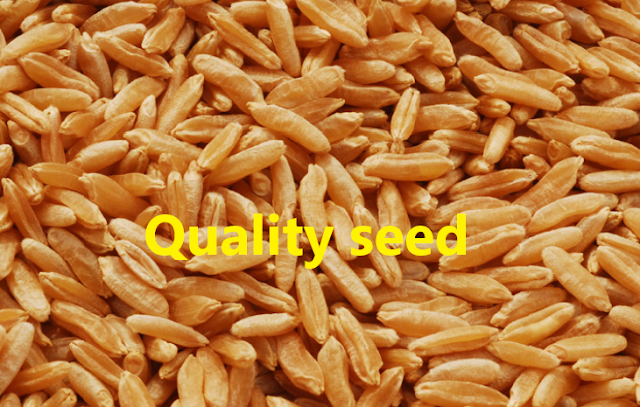 |
| What is quality seed and the qualities of a good seed. |
Quality seed
The seeds which contain the desirable characteristics to grow crop is known as quality seed.
Quality seed is defined as varietally pure with a high germination percentage, free from disease and disease organisms, and with a proper moisture content and weight. Quality seed insures good germination, rapid emergence, and vigorous growth.
Qualities of a good seed
1. Physical health of the seed: A seed must be in normal health and bright in colour. If any physical or mechanical spot in it, the production will be hampered.
2. Purity of seed: A good seed must be genetically pure and it should be free from all sorts of contamination. In other word, the seed should be free from other crop seed, weed seed and inert materials.
3. Plumpness of seed: A good seed must be plumped and its all organs should well developed specially the embryo should be well developed and matured.
4. Germination viability of seed: A seed must be viable and it has definite life span. The seed must have the germination capacity.
5. Vigor of seed: The organic power of the seed is called seed vigor. A good seed must have sufficient amount of organic power. It helps in root initiation and leaf formation.
6. Maturity of seed: A good seed must be well matured both externally and internally. The germination capacity and seed vigor depend upon the maturity of seed.
7. Moisture content of seed: A good seed must contain a definite amount of moisture. The amount of moisture depend on the type, variety, species of seed. Generally, the cereal contain 12-14% moisture where the jute contain 7-8% moisture.
8. Size of seed: The quality seeds are same in size. The size of all seeds in a crop are not same. Good seeds are not extra – large or extra – small , that’s should be in optimum size and shape.
9. Weight of seed: With the limitation, a good quality seed must be heavy in weight that contain more food material for growth of embryo. A heavy weight wheat seed can contain 2mg carbohydrate.
10. Age of seed: A good quality seed must be congenial aged. When the age of seed is more, it may reduce the longevity and germination capacity of seed.
11. Free from disease and insect: A good quality seed must be free from disease and insect. Diseases make the seed vigor-less, less viable seeds and decrease the percentage of germination.
Useful Agricultural Websites